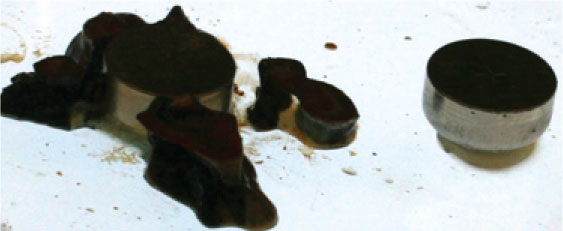Batteries become safe to swallow with spongy covering
New coating switches from a conductor to an insulator to prevent injury
Eating a battery may no longer require a trip to the emergency room.
With squishy silicone and tunneling electrons, researchers have created coated batteries that prevent unwanted zaps. The quantum-inspired coating works by switching from being a conductor —which it is when squeezed into an electronic gadget’s battery housing —to an insulator when it’s taken out and, perhaps, accidentally gulped. The finding, appearing November 3 in the Proceedings of the National Academy of Sciences, could help avert the estimated 5,000 hospital visits due to battery ingestion each year in the United States.
“Children love to place foreign objects into their mouth, nose and ears,” says pediatric surgeon Albert Park of the University of Utah in Salt Lake City. Button batteries, the kind used in the study, are particularly dangerous, Park says.
Named for their size and shape, button batteries are found in watches, toys and other common doodads. Their small size makes them easy to swallow but they can get stuck in a person’s throat, where they can cause injury within a few hours. In the digestive tract, batteries can leak electrical current that blasts water molecules apart and causes damage similar to chemical burns.

To diffuse that danger, researchers led by bioengineer Jeffrey Karp and Bryan Laulicht at Harvard Medical School turned to a newfangled material called a quantum tunneling composite, or QTC. This material is similar to those used in touch-screen devices and can be bought off-the-shelf. The composite includes wee balls of a conductive metal sprinkled throughout a spongy matrix of silicone polymer.
On a battery, a 1-millimeter-thick coating of the QTC acts as an insulator, sealing in current to keep it from causing harm. But when the coated battery is pressed or squished into a standard battery housing in an electronic device, the coating becomes a conductor. In that compressed state, the coating’s conductive metal balls are pushed closer together, getting within about five nanometers of each other. At that distance, the balls can ferry electrons through the silicone matrix. That channeled current is explained by quantum mechanics because the electrons exhibit wavelike properties to move across the silicone barrier.
In laboratory tests, Karp and colleagues found that the coated batteries worked as well as regular ones in electronic devices —powering a laser pointer as a demonstration. In watery experiments that mimic human gut conditions, the coated batteries held in their electrons, while regular batteries gushed current into their surroundings. In a pig’s throat, the coated battery caused no harm.
“This is a really simple solution to a big problem,” Karp says of the QTC-coated batteries. The researchers have filed a patent application and are now working on a scalable design. With around 5 billion batteries made each year, he says, it’s important to figure out a way to mass produce them.







